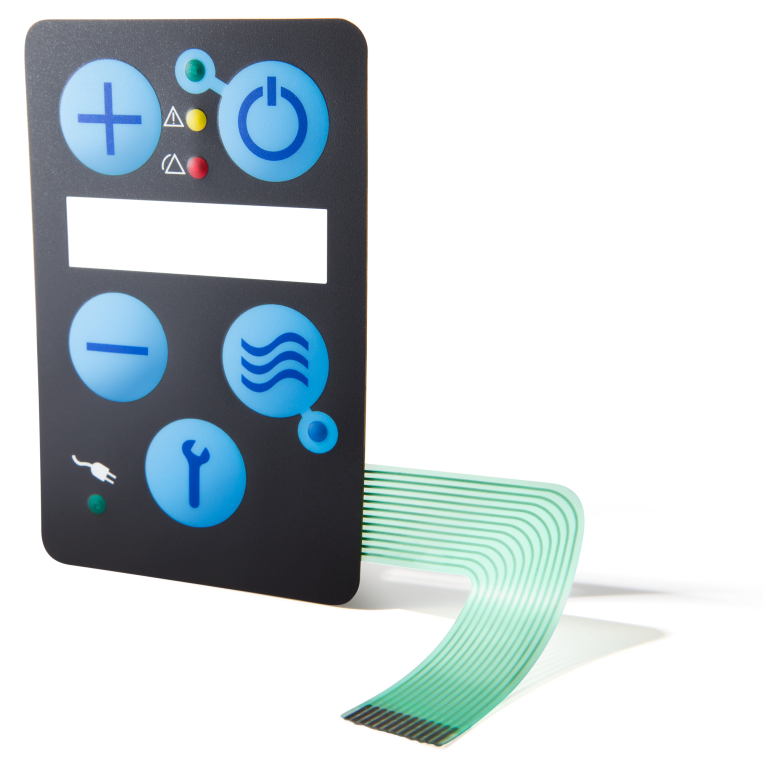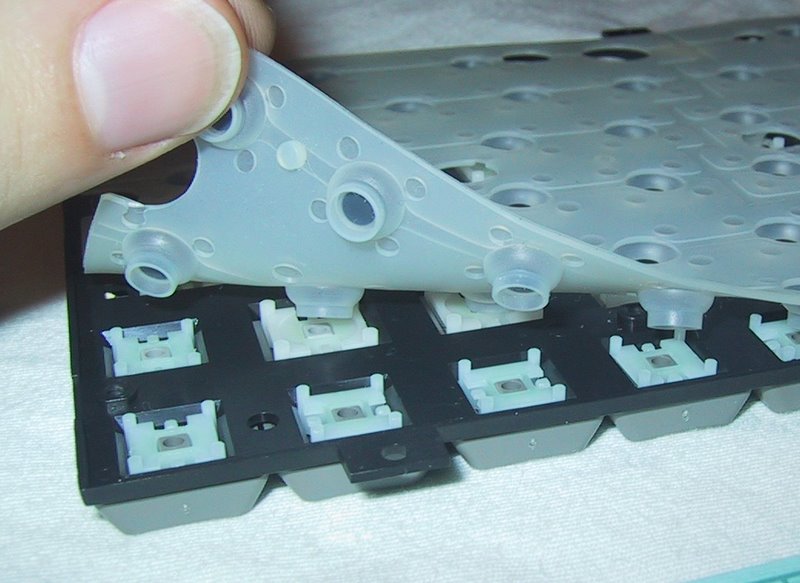Full-Service Membrane Switch Manufacturer for Targeted Applications
Full-Service Membrane Switch Manufacturer for Targeted Applications
Blog Article
Exploring the Manufacturing Process of Membrane Switch for Various Industries
The production process of Membrane switches is a complicated endeavor that demands precision and focus to information. From choosing proper materials to implementing extensive quality assurance procedures, each action plays an essential duty in ensuring functionality. Different industries, including medical and auto, count on these elements for their one-of-a-kind applications. Recognizing the details of this process discloses considerable understandings right into just how these switches are generated and their influence across diverse markets.
Understanding Membrane Changes: A Review

Trick Materials Utilized in Membrane Switch Manufacturing
In Membrane switch production, the selection of crucial products significantly affects capability and toughness. Conductive products, adhesives, and finishes play essential functions, while substrate option affects general performance and integrity. Comprehending these elements is crucial for enhancing the style and manufacturing of Membrane switches.
Conductive Materials Introduction
Conductive materials play an important role in the performance of Membrane buttons, making certain trustworthy electrical links within the tool. Typically utilized materials consist of silver, copper, and carbon-based inks, each offering distinctive advantages. Silver is preferred for its high conductivity and toughness, making it suitable for applications requiring robust efficiency. Copper, while somewhat much less conductive than silver, is a cost-effective alternative commonly used in published circuits. Carbon-based inks offer a flexible option, suitable for applications where adaptability and reduced prices are focused on, although they have lower conductivity compared to metal choices. The selection of conductive materials straight affects the total integrity, life expectancy, and efficiency of the Membrane button, making it a vital consideration in the manufacturing process.
Adhesives and Coatings
Adhesives and finishes are crucial parts in the manufacturing of Membrane buttons, supplying essential bonding and safety properties. These products assure that different layers of the switch, including visuals overlays and wiring, adhere safely to each other, boosting resilience and performance. Generally made use of adhesives include pressure-sensitive adhesives (PSAs) and epoxy-based formulas, which use solid attachment and resilience. Coatings, such as polyurethane or acrylic, offer to protect against environmental factors, consisting of dampness, abrasion, and chemicals. Additionally, coverings can improve responsive comments and aesthetic allure, adding to the general individual experience. The selection of proper adhesives and finishings is critical for maximizing efficiency and long life in diverse applications throughout numerous markets, making certain that Membrane changes meet certain functional needs.
Substratum Choice Variables
Substrate selection plays a necessary role in the production of Membrane switches, as it considerably influences their total efficiency and durability. Key products such as polyester, polycarbonate, and flexible printed circuit boards (FPCBs) are typically made use of for their distinct buildings. Polyester is preferred for its cost-effectiveness and resistance to abrasion, making it suitable for applications with high wear. Polycarbonate deals exceptional clarity and influence resistance, suitable for environments calling for high exposure. FPCBs offer enhanced flexibility and are often made use of in intricate styles. The selection of substratum additionally influences variables like thermal security, chemical resistance, and simplicity of printing. Eventually, picking the suitable substrate is important for making sure the functionality and durability of Membrane switches across different markets.
The Style Refine of Membrane Switches
The layout procedure of Membrane switches is an important phase that significantly influences the performance and appearances of the final item - membrane switch manufacturer. It begins with specifying the certain requirements of the application, consisting of measurements, button design, and tactile responses choices. Designers have to consider individual communication, making certain that the button is intuitive and accessible.Next, materials are selected based upon resilience, adaptability, and ecological resistance. The integration of graphics and branding aspects is additionally vital, as it boosts aesthetic appeal and interaction. Prototyping enables repetitive testing, allowing modifications based upon customer responses and efficiency evaluations.Additionally, the style has to make up the electric parts, such as ports and circuits, guaranteeing reliability and convenience of use. Inevitably, a successful layout balances functionality, aesthetics, and individual experience, leading the means for effective manufacturing and lasting performance in various markets
Printing Strategies for Membrane Switches Over
The printing techniques utilized in Membrane button production play a crucial function in establishing the last item's top quality and functionality. Display printing provides benefits such as toughness and lively color application, while digital printing developments provide flexibility and accuracy in style. Understanding these techniques can substantially impact the overall efficiency of Membrane switches in numerous applications.
Screen Printing Benefits
Many benefits make display printing a preferred method for producing Membrane buttons. This approach permits premium, comprehensive styles and lively colors, which are essential for user interface applications. Screen printing is especially effective for using thick ink layers, enhancing longevity and responsive responses. Additionally, it supplies outstanding bond to various substratums, ensuring longevity sought after atmospheres. The procedure is economical for big production runs, as it lessens configuration time and waste. Screen printing supports a vast array of inks, consisting of specialty and UV-curable choices, allowing flexibility in design. Its capability to produce constant outcomes throughout several units makes it a trusted choice for manufacturers aiming for quality and effectiveness in Membrane button manufacturing.
Digital Printing Innovations

Improvements in digital printing technology are click for info transforming the manufacturing of Membrane buttons, supplying makers innovative remedies that boost design adaptability and efficiency. Digital printing permits high-resolution graphics and intricate styles, making it possible for custom-made branding and functionality without the limitations of conventional techniques. This method minimizes arrangement times and costs, assisting in shorter manufacturing runs and minimal waste, making it excellent for businesses with differing needs. Additionally, innovations in ink formulations provide much better durability and adhesion, making sure durability in different environments. As industries significantly seek tailored and intricate designs, electronic printing stands out as an important method, establishing a brand-new standard in Membrane switch manufacturing. The combination of these advancements positions makers to satisfy advancing market needs properly.
Assembly and Layering of Membrane Switch Parts
Cautious setting up and layering of Membrane button elements are necessary to ensuring performance and toughness. This process starts with the exact positioning of different layers, including the visuals overlay, glue, circuit layer, and backing product. Each part has to be meticulously positioned to preserve electric stability and interface responsiveness.During assembly, conductive traces are used to the circuit layer, commonly made from products like polyester or polycarbonate. This layer is important, as it transfers signals when stress is applied. The adhesive utilized for bonding these layers is additionally chosen for its capacity to withstand environmental anxieties while maintaining a secure bond.Heat and pressure are usually used during the assembly procedure to identify that the layers stick correctly without jeopardizing the functionality of the button. Ultimately, interest is offered to the edge sealing to shield against wetness and impurities, securing the durability of the Membrane button in different commercial applications.
Quality Assurance Steps in Membrane Switch Manufacturing
Quality control the original source actions play a necessary duty in making certain the integrity and efficiency of Membrane changes adhering to the assembly and layering of their parts. In the manufacturing procedure, several crucial inspections are conducted to promote top quality standards. These include aesthetic examinations for defects in printing and glue application, as well as practical tests to verify the responsiveness of each switch.Additionally, ecological screening is performed to examine the buttons' toughness against temperature variations and moisture exposure. Producers frequently execute analytical process control (copyright) techniques to check production consistency, making it possible for early discovery of anomalies.Furthermore, traceability systems are established to track products and components, making sure liability and promoting recalls if necessary. Calibration of equipment and adherence to industry requirements are also essential to maintaining item integrity. Collectively, these quality assurance actions safeguard the efficiency of Membrane switches across numerous applications, ultimately boosting consumer fulfillment.
Applications of Membrane Switches Across Different Industries
Membrane switches are utilized throughout a varied variety of sectors, showcasing their flexibility and adaptability. In the medical field, they supply water-proof and dependable interfaces for tools such as analysis equipment and infusion pumps, making certain hygiene and simplicity of usage. The automobile sector uses Membrane switches for control panel controls, allowing seamless communication in between the motorist and vehicle systems.In consumer electronic devices, these buttons are discovered in devices and handheld devices, offering a streamlined, modern visual while enhancing performance. Industrial applications likewise take advantage of Membrane switches for machinery control panels, where longevity and resistance to extreme conditions are essential.Furthermore, the aerospace and protection industries make use of Membrane buttons for cabin instrumentation and interaction systems, focusing on integrity and performance under severe problems. Generally, Membrane buttons play a vital function see this in boosting the individual experience and operational performance across different domain names.
Often Asked Inquiries
How Long Does It Require To Produce a Membrane Switch?
The manufacturing time for a membrane layer button normally ranges from a few days to a number of weeks - membrane switch manufacturer. Aspects affecting this period include design intricacy, material accessibility, and manufacturing volume, all affecting the general timeline noticeably
What Is the Common Lifespan of a Membrane Layer Switch?
The regular life-span of a membrane switch usually varies from 1 to 5 million actuations, relying on variables such as worldly top quality, environmental conditions, and use frequency, considerably affecting longevity and total performance.
Can Membrane Switches Over Be Customized for Details Applications?
Membrane buttons can certainly be personalized for specific applications. Their design adaptability permits modifications in dimension, shape, shades, and graphics, ensuring compatibility with one-of-a-kind demands throughout numerous markets and enhancing functionality and customer experience.

Are Membrane Switches Eco-friendly?
The environmental influence of Membrane switches over varies. Some products used may not be green, while innovations in making procedures are significantly concentrating on sustainability, intending to decrease waste and promote recyclable elements in their production.
What Are the Typical Failure Modes of Membrane Switches?
Usual failing settings of Membrane switches consist of delamination, sticky failure, deterioration from usage, wetness access, and electrical failings. These issues can significantly influence performance, efficiency, and life expectancy in various applications across various sectors. Membrane switches can be customized to fit specific design demands, such as functionality, shape, and size, making them extremely adaptable.The building usually includes multiple layers, consisting of a graphic overlay, adhesive, and a circuit layer, which work with each other to develop a smooth user experience. In Membrane switch production, the choice of key products substantially affects functionality and resilience. The automotive market employs Membrane switches for control panel controls, allowing smooth communication between the vehicle driver and lorry systems.In customer electronics, these switches are discovered in devices and handheld tools, providing a smooth, contemporary aesthetic while improving functionality. Industrial applications likewise take advantage of Membrane switches over for machinery control panels, where longevity and resistance to severe problems are essential.Furthermore, the aerospace and protection markets use Membrane switches for cabin instrumentation and communication systems, prioritizing reliability and performance under severe conditions. Membrane buttons can indeed be personalized for particular applications.
Report this page